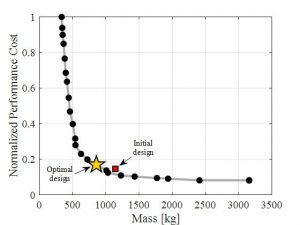- caryel2@illinois.edu
- PhD Candidate – University of Illinois
- MS Mechanical Engineering – University of Illinois (2021)
- Bachelor in Mechanical Engineering – Auburn University (2018)
- B.S. in Physics – Auburn University (2018)
- Research Interests: Control & Design Optimization for Power & Thermal Systems
- CV
Previous & Current Work
Advances in power density are crucial to the increased electrification of vehicles. My work focuses on modeling, design optimization, and control strategies to improve power density of future electrified vehicles and vehicle subsystems.
Energy storage is a crucial technology in electrified vehicle industries, as vehicles rely heavily on electrical energy storage for vehicle propulsion, passenger comfort, and support of vital loads. Many electric vehicle applications experience electrical loads with high peak-to-average power requirements, and these high peak loads can be damaging to traditional energy storage devices such as batteries. Due to the inherent linkage between the electrical and thermal domains, electrical loads often produce significant thermal loads, and thus careful attention must be paid to thermal management systems for vehicle applications. Typically, electrical and thermal energy storage are treated separately; my previous work focused on combining electrical and thermal energy storage for these applications. This work leveraged the concept of hybrid energy storage (HES) – incorporating multiple, dissimilar energy storage elements for improved system-level performance – in both electrical and thermal domains. An HES system consisting of battery and ultracapacitor cells was considered in the electrical domain, and in the thermal domain, a system integrating phase change material (PCM) and single-phase coolant was considered. I developed models for hybrid electro-thermal energy storage systems which were used to demonstrate that HES is a valuable technology for high peak power applications [1]. Other previous work has focused on control of HES systems using model predictive control techniques [2]. Additionally, my previous work has focused on applying a graph-based design optimization framework for integrated optimization of plant and controller for these systems [3-5]. Using a hybrid electro-thermal energy storage system as a case study, we found that our framework can be used to increase power density by making significant reductions in system mass while retaining performance, as shown in Figure 1.

My current work builds on these graph-based methods to develop computationally efficient energy management strategies. I am focusing on validating these methods to rapidly plan the operation of a hybrid-electric UAV powertrain.
Conference Publications
[1] C.E. Laird and A.G. Alleyne, “A Hybrid Electro-Thermal Energy Storage System for High Ramp Rate Power Applications,” ASME 2019 Dynamic Systems and Control Conf., 2019.
[2] H.C. Pangborn, C.E. Laird, and A.G. Alleyne, “Hierarchical Hybrid MPC for Management of Distributed Phase Change Thermal Energy Storage Under Pulsed Loading,” American Control Conference, 2020.
[3] C.E. Laird, D. Docimo, C.T. Aksland, A.G. Alleyne, “Graph-Based Design and Control Optimization of a Hybrid Electrical Energy Storage System,” ASME 2020 Dynamic Systems and Control Conf., 2020.
Journal Publication
[4] C. Laird, Z. Kang, K. A. James, and A. G. Alleyne, “Framework for integrated plant and control optimization of electro-thermal systems: An energy storage system case study,” Energy, vol. 258, p. 124855, Nov. 2022, doi: 10.1016/J.ENERGY.2022.124855.
MS Thesis
[5] C. Laird, “Modeling, control, and design of hybrid electrical and thermal energy storage systems,” MS Thesis, University of Illinois at Urbana-Champaign, 2021.
